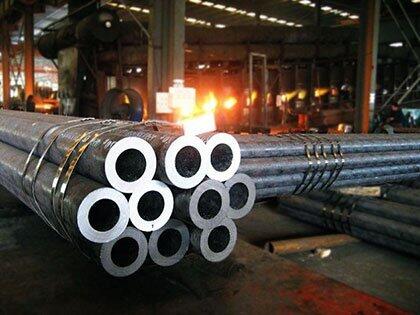
1. Material Grade
Ordinary carbon steel (such as Q235) has a tensile strength of approximately 375-500 MPa, while high-strength carbon steel (such as X60) can reach over 517 MPa (referring to API 5L standard). The higher the material strength, the greater the pressure resistance.
2. Wall Thickness and Outer Diameter
According to the Barlow formula (P = (2 * S * t) / D, where P is the pressure resistance value, S is the material tensile strength, t is the wall thickness, and D is the outer diameter), for the same material, a 1mm increase in wall thickness can increase pressure resistance by approximately 10-15%. For example, a DN100 SCH 40 carbon steel pipe (6mm wall thickness) has a working pressure of approximately 5.6 MPa, while SCH 80 (8mm wall thickness) can reach 7.4 MPa (ASTM A106 data).

3. Manufacturing Process
Seamless steel pipe (such as ASTM A106) can withstand higher pressures than welded pipe (such as ASTM A53) because it lacks weak points like weld seams.
4. Operating Temperature
As the temperature rises, the material strength decreases, and the allowable pressure decreases. At room temperature, the allowable stress of ASTM A106 Grade B steel is approximately 138 MPa. When the temperature rises to 400°C, the allowable stress drops to around 100 MPa.
For example, a flange labeled PN16 has a maximum allowable working pressure of 16 bar (approximately 1.6 MPa) at 20°C. As the temperature rises, the maximum allowable working pressure decreases.
The following are several commonly used pressure rating standards for carbon steel pressure piping:
a. American Standard Pressure Rating: The American National Standard ANSI B16.5 defines the classification criteria for American Standard pressure ratings. Common pressure ratings include 150, 300, 600, 900, 1500, and 2500.
b. European Standard Pressure Rating: The European Standard EN1092-1 defines European Standard pressure ratings. Common pressure ratings include PN2.5, PN6, PN10, PN16, PN25, PN40, PN63, PN100, PN160, and PN250.
c. Japanese Standard Pressure Rating: The Japanese Standard JIS defines Japanese Standard pressure ratings. Common pressure ratings include 5K, 10K, 16K, 20K, 30K, and 40K.
2. Wall Thickness Series (Schedule, Sch)
This is the most commonly used method for expressing the pressure capacity of seamless and welded steel pipes. The Schedule Number is a dimensionless number representing the wall thickness grade of the pipe. Its calculation formula takes into account the design pressure and the material's allowable stress.
1. Safety Factor: Industrial piping typically uses a safety factor of 1.5-4 times the design pressure (a higher value is used for flammable media). For example, steam piping requires an additional corrosion allowance according to ASME B31.1.
2. Temperature Correction: The pressure resistance of carbon steel pipe decreases by approximately 20-30% at high temperatures (>200°C). The material temperature reduction factor should be considered.
3. Corrosive Environment: If the medium contains H₂S or CO₂, sulfur-resistant carbon steel should be used or the design pressure should be reduced by at least 30%.Calculation: Use the above formula, substituting the design pressure, OD, and material allowable stress, to reverse-calculate the required minimum wall thickness t.
Table Lookup: Based on the calculated minimum wall thickness, compare it to the ASME B36.10 standard wall thickness table and select a schedule number (such as Sch40 or Sch80) with an actual wall thickness no less than the calculated value.
5. Verification: Ensure that the pressure-temperature rating of the selected pipe (calculated) exceeds the system requirements under all operating conditions, with an appropriate safety margin.
Read more: Schedule 80 Carbon Steel Pipe
Related information
